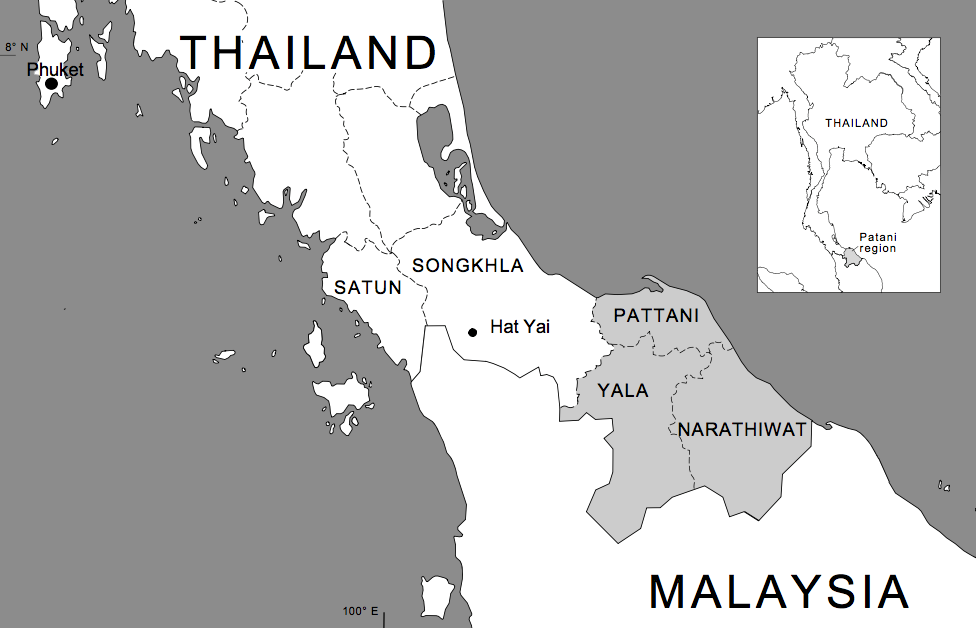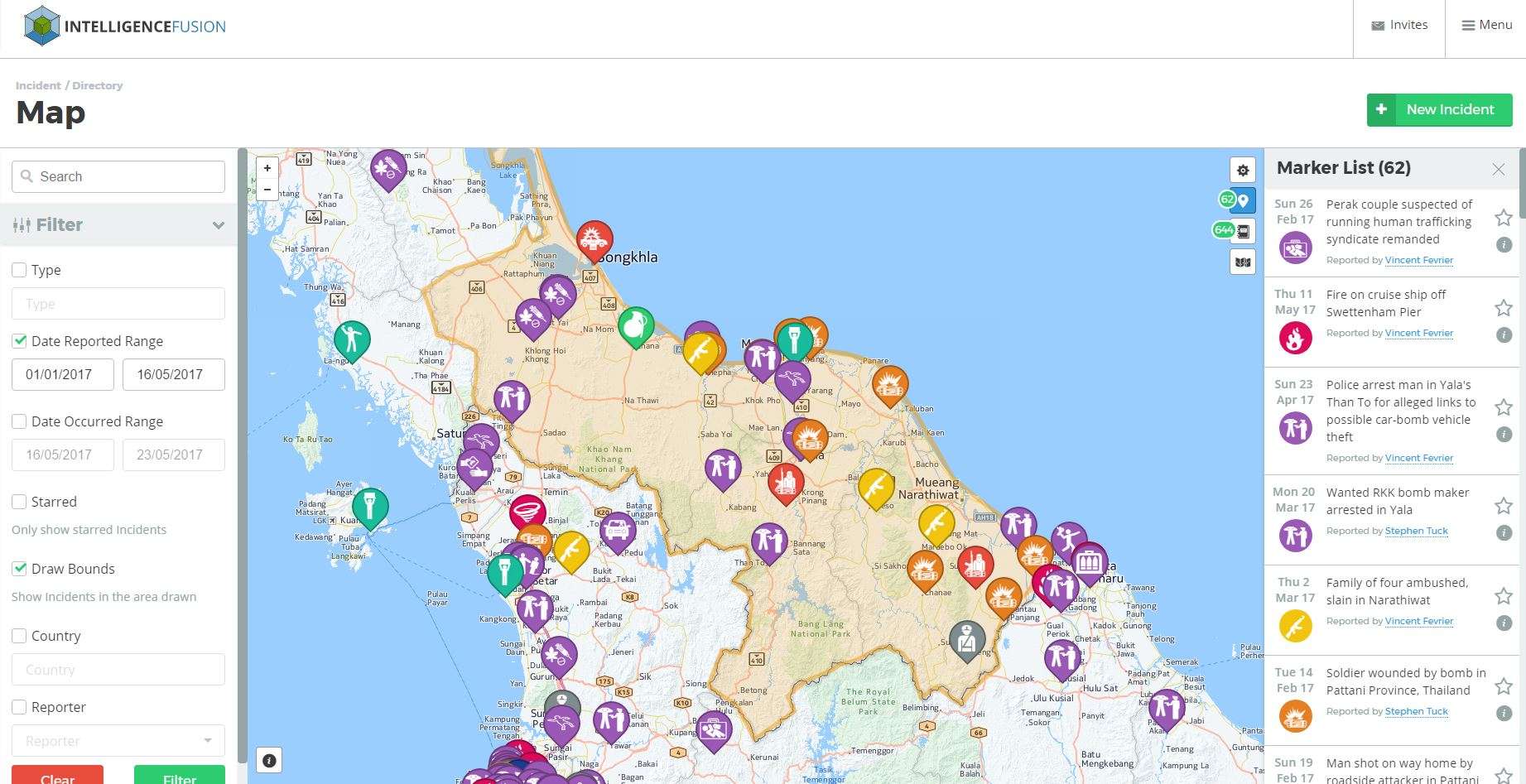Southern Thailand: Instability in Patani, a Threat to the Greater Region

An area of the world which has been under-reported so far in 2017 has been the southern provinces of Thailand, on the border with Malaysia. Multiple violent events have occurred, but because of its local nature, limited reporting has been dedicated to it. Since the late 1950âs, an insurgency against the Buddhist-majority led government has been ongoing in the region of Patani and its provinces, and violence since the beginning of 2017 has been significant.
The Patani region, located in the northern part of the Malay peninsula, is made up of the provinces of Pattani, Yala, Narathiwat, and parts of Songkhla. It used to incorporate the province of Kelantan, which is now part of north-eastern Malaysia. Because of its proximity to Malaysia, the region has historically been predominantly made up of those of Malay ethnicity. Malay are primarily Sunni Muslims, and religion has played a large part of the conflict, as those seeking to secede from Thailand, were looking to do so to form an Islamic Republic.
Insurgency began due to continuous refusal by the Thai government to see those living in Patani as an ethnic minority. In 1959, the first Malay rebel group, the Patani National Liberation Front (BNPP) was formed. In 1968, the Patani United Liberation Organisation (PULO) was established, who are now identified more as a political wing, and both organisations had secession as their goal in this conflict. Secession was meant to be achieved through armed conflict by fighting the Thai government. In the late 20th Century, new groups emerged in the south, all with a proclivity for violence, but were ineffective due to fighting among themselves.
These ineffective groups were replaced in the early 2000âs by groups waging war against the government using guerrilla style tactics. One of the main difference of these groups and those previously in existence is that these new groups remain silent about their attacks, not claiming credit, and do not have the typical structures of traditional groups who had set leaders. This type of structure makes it difficult for the government to dismantle them, as a lack of structure means there is nothing to dismantle. Of these new groups, the two that have been identified as leading the insurgency since 2005 have been the BRN-Coordinate and their armed wing, the Runda Kumpulan Kecil (RKK).
Barisan Revolusi Nasional Melayu Pattani- The group was founded in 1963. It is a Patani independence movement located in northern Malaysia and Patani in southern Thailand. It is the most powerful group in the region and began as an independence movement, but evolved as time went by, and a sub-group, the BRN-C, became its most active wing leading the insurgency in the south. The BRN-Koordinasi (BRN-C) is currently the largest, most active, and most organized of the BRN subgroups. The BRN-C favors a more radical ideology and is involved in mosques and Islamic schools in the region, with its main recruitment target being youth. The immediate aim of the group is to ensure chaos reigns leading to weak Thai governance in the region. The BRN-C is thought to be at the origins of the Runda Kumpulan Kecil.
Runda Kumpulan Kecil (RKK) – founded in 2002, it is one of the most active violent groups in the southern provinces of Thailand. As an offshoot of the BRN-C, some do not consider them totally independent. The group works as a loosely organized system of cells. Because of its mobility, and the fact that not much is known about them, it is very hard for the Thai government to infiltrate their structure. It is reported that they have received their training in Indonesia.
Pattani Islamic Mujahedeen Movement (GMIP) – founded in 1995, the GMIP is like the RKK is violent and has a penchant for not taking credit for its attacks. There is a belief that the group has links to Al-Qaeda, and has for a goal to establish an Islamic State in Pattani.
The first few months of 2017 have seen a large amount of attacks by insurgent groups in the southern provinces of Thailand. These have included ambushes and attacks using improvised explosive devices and vehicle-borne explosives. While most targets have been against policemen and soldiers, the groups have also targeted civilians and infrastructure in some of their attacks. The month of April was particularly busy with several days of large scale coordinated events taking place.


Click on above image to expand.
April 2nd-3rd- Insurgents launched a late-night attack on a join police-military checkpoint in Yalaâs Krong Pinang district, resulting in 12 policemen suffering injuries. Intelligence said that the attack which included the checkpoint attack, as well as the use of road spikes and several pipe bombs and the felling of trees and burning tires, was probably carried out by a Runda Kumpulan Kecil (RKK) operations unit.
April 6th- 31 coordinated attacks including:
2 bomb attacks in Sungai Kolo District3 bomb attacks in Tak Bai2 bomb attacks in Ru Soh1 bomb attack in Waeng district1 bomb attack in Bacho districtThree electrical poles were damaged with homemade bombs in the village of Joh Bantang and in Bannang districtPower transformer in front of the Bannang Sata Tambon office was torchedTires and a electrical pole were set alight in three villages in Thanto districtFour insurgents riding on two motorcycles planted a bomb in front of Ban Pareh School in Mueang district and detonated it soon after. A second bomb was found later.Militants detonated three bombs and set tires aflame in front of a college in Nong Chik districtMilitants used explosives to damage utility poles in various locations in Yaran and Yarang districtsIn Songkhla, insurgents torched tires in front of a rubber plant in Chana district and burned down utility poles in two Saba Yoi district villages
April 19th- Multiple coordinated attacks including:
4 black-clad suspects threw bomb at an outpost within the Sungai Padiâs Toh Deng train station. This injured one defense volunteer. The suspects opened fire for five minutes before fleeing.Two insurgents on a motorbike opened fire at soldiers in Thepha district, injuring a woman bystander.Two insurgents on a motorcycle threw a grenade at a police booth in front of Chana Police Station. No injuries reported.Two would-be bombers were killed when their homemade motorcycle bomb exploded prematurely.Two attacks in Yarang and one each in Kapho, Muang, and Ma Yor
April 27th- Six Thai rangers killed in an ambush in Narathiwat province. The truck carrying the patrol was hit by an IED, and four of the rangers were gunned down at the scene, and 2 later died in the hospital.
These attacks are a testament to the chaos the groups bring to the region, and to the variety of people and infrastructure being targeted from soldiers, policemen, and civilians, to police outposts, train stations, schools, and power lines. While these attacks have not been claimed by any group, it is not farfetched to assume that the BRN-C and the RKK are behind them, as their goal is to make the region ungovernable, and these attacks suit that aim. The month of May seems as if it is a continuation of the destruction caused in the previous month. Two significant events in the start of this month have been an ambush on a patrol of soldiers, and a vehicle-borne explosive going off in front of a supermarket in the city of Pattani, injuring over 50 people.
So, is there an end in sight to this insurgency through a peace process?
For the moment, it does not look like one will be reached soon. On April 10th, the BRN made a statement highlighting their demands for any peace talks. These terms included the participation of foreign governments, and an agreement on the terms for negotiation by the two opposing parties â Thailand and the BRN. While the BRN says, it is ready to talk, it also says that it is under no pressure to do so. This shows a lack of true engagement for peace, and it is unlikely anything can occur based on this.
Additionally, presently, the Thai government prefers to hold peace talks with MARA Patani, an umbrella organisation of different separatist movements, which has been in talks with the government for the past two years. In February, the group announced that along with the Thai government, they had agreed to establishing safe zones (2 in Yala, 2 in Narathiwat, 1 in Pattani), yet they had not yet decided on which districts within those provinces would be selected.
In the same statement made by BRN on April 10th, they say that MARA Patani does not speak for them, as they have not been given the mandate to hold talks on their behalf with the government. They did say that MARA Pattani would be allowed to join any BRN-led peace talks, but would do so as an organisation and not as representation for all separatist groups. This reinforces the notion of the varied structures among the groups, with no set leadership structure. It does show that MARA Patani does not speak for everyone in the region. It is for this reason, that unless the government makes the decision to negotiate with the individual representation of the groups, rather than an umbrella organisation, no peace talks would be successful. Based on the structure of each organisation, this approach to negotiations may not even work regarding including everyone, as certain factions may decide to break off and continue to insurgency on their own terms.
Is there a threat to the region?
South East Asia has porous borders, which for years has allowed the movement of illicit drugs, weapons, and human trafficking between them. We have seen, regarding the southern Philippines, how militants have travelled through Malaysia and Indonesia to reach Mindanao and the Sulu Archipelago, posing a threat to countries around the Philippines. Therefore, it is not far-fetched that the instability in the southern provinces of Thailand poses a threat to other countries in the greater region.
Instability and a lack of strong governance in the region allows terror groups and transnational criminal networks to use the context to their advantage. This was exemplified during the first week of May, when on May 3rd it was reported that the leader of an Islamic State terror cell in northern Malaysia in the province of Kelantan, had fled across the border into southern Thailand, after members of his cell were arrested over the course of the first few months of 2017. A report by Malaysian authorities two days later mentioned that this terror cell may have been smuggling weapons from southern Thailand for a year to prepare attacks at home and abroad. These reports show the detrimental effect instability within one country can have on the greater region.
The Thai army have not made inroads to tackling the insurgency in southern Thailand due to a lack of training in counter-insurgency, a lack of understanding of the local dynamics and cultural identity, and because of rivalry and distrust between the army and the police. It is alleged that local policemen have been involved in the illicit drug trade, and therefore military commanders in the capital distrust them. A lack of cooperation between the two does not bode well for security operations in the region.
Until work is done to shore up the security presence in southern Thailand with equipped and trained members of the armed forces and police, these insurgent groups will continue to wage guerrilla warfare. With the report from Malaysia stating that the Islamic State terror cell had been smuggling weapons into the country from southern Thailand, we may see an increased security presence along the border in the province of Kelantan for the time being. Similarly, after the car bombing on May 9th, the Thai army may increase its presence in the provinces in the region of Patani. At the time of this report, there has not been any signs that this is the case, but things may evolve as the situation is fluid.
